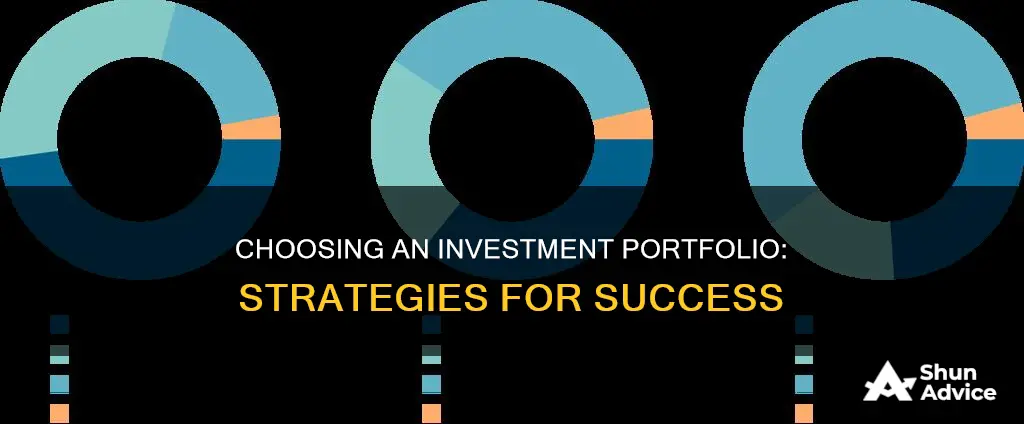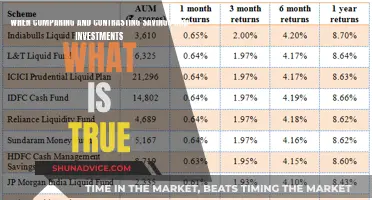
Choosing an investment portfolio can be a daunting task, but it is an important step towards achieving your financial goals. The process involves deciding how much help you want, selecting an account that aligns with your goals, and choosing investments that match your risk tolerance and time horizon. Diversification is key, and a blend of stocks, bonds, and other asset classes can help strike a balance between risk and reward. It's also crucial to periodically review and rebalance your portfolio as your risk tolerance and goals evolve. Building an investment portfolio requires careful consideration and an understanding of your financial situation, risk appetite, and investment options.
| Characteristics | Values |
|---|---|
| Risk tolerance | Depends on income, expenditure, and willingness to take risks |
| Time horizon | Depends on the time period for which you expect to hold an investment |
| Investment goals | Retirement, children's education, large purchases, starting a business, leaving a financial legacy |
| Investment types | Stocks, bonds, mutual funds, exchange-traded funds (ETFs), real estate investment trusts (REITs), commodities, forex, international stocks, cash investments, hybrid securities, alternative investments, call options, put options, index funds, fixed-income securities, multi-asset funds, sector funds, specialty funds, factor-based funds |
| Diversification | Different asset classes, sectors, industries, and markets |
| Costs | Brokerage fees, mutual fund expense ratios, investment costs |
What You'll Learn

Understand your risk tolerance
Understanding your risk tolerance is a critical aspect of choosing an investment portfolio. It refers to your ability to accept potential losses in exchange for higher returns. Your risk tolerance depends on your financial goals, investment horizon, income, expenditure, and willingness to take risks.
Firstly, consider your financial goals and investment horizon. Short-term goals are those you want to achieve in less than three years, mid-term goals range from three to ten years, and long-term goals will take over ten years to accomplish. For example, a vacation or home renovation is a short-term goal, while saving for a child's college education is a mid-term goal, and retirement planning or buying a house is a long-term goal. Your portfolio should include a mix of assets that mature in time to meet these goals.
Secondly, evaluate your comfort with taking on risk. All investments carry some degree of risk, and it's important to understand that you could lose money. If you have a long-term financial goal, you are likely to make more money by investing in riskier assets like stocks or bonds. On the other hand, if you are saving for a short-term goal, investing in cash equivalents or low-risk assets may be more appropriate.
Your risk tolerance is also influenced by your income, expenditure, and willingness to take risks. If you have a higher income, you may be more comfortable taking on more risk. Conversely, if you have more dependents and expenses, you may be less willing to take on risk. Age can also play a factor, as those closer to retirement may be less willing to tolerate high risk.
Additionally, consider the impact of inflation on your investments. Inflation risk refers to the chance that the returns from your portfolio will be lower than expected due to inflation. This is especially relevant for fixed-income securities and bonds.
Finally, remember that your risk tolerance may change over time as your circumstances evolve. Periodically reviewing and rebalancing your portfolio is essential to ensure it remains aligned with your risk tolerance and financial goals.
Who Runs Berkshire's Investment Portfolio?
You may want to see also

Diversify your portfolio
Diversifying your portfolio is a crucial aspect of investment management. It involves spreading your investments across various assets, such as stocks, bonds, mutual funds, exchange-traded funds (ETFs), real estate investment trusts (REITs), commodities, forex, and international stocks. Diversification helps to balance risk and reward by reducing exposure to any one type of asset. Here are some detailed strategies to diversify your portfolio:
- Spread the Wealth: Avoid putting all your money in one stock or sector. Consider investing in a diverse range of companies you know and trust, or even use in your daily life. Diversify across different sectors and geographies to spread your risk and potentially achieve bigger rewards.
- Consider Index or Bond Funds: Index funds and fixed-income funds can be a great addition to your portfolio. They tend to have low fees and aim to match the performance of broad market indexes. By investing in securities that track various indexes, you can achieve long-term diversification and hedge against market volatility.
- Keep Building Your Portfolio: Regularly add to your investments using strategies like dollar-cost averaging. This approach smooths out market volatility by investing the same amount of money over time, buying more shares when prices are low and fewer when prices are high.
- Know When to Get Out: While buying and holding is a sound strategy, stay informed about your investments and overall market conditions. Be prepared to cut your losses and move on to the next investment opportunity when necessary.
- Keep an Eye on Commissions: Understand the fees associated with your investments. Some firms charge monthly or transactional fees, which can chip away at your profits. Be aware of what you are paying and whether there are any changes to your fee structure.
- Asset Allocation: Determine the right mix of assets for your portfolio based on your risk tolerance and investment goals. Consider your time horizon, financial needs, and comfort with volatility. Diversify across different types of investments, such as stocks, bonds, cash, and alternative assets.
- Risk Diversification: Different assets carry different levels of risk. Invest across a variety of assets to minimise the impact of risks associated with any single asset class. Balance high-risk, high-return investments with low-risk, low-return assets.
- Emergency and Health Insurance: Include an emergency fund and adequate health insurance in your portfolio. These components protect your portfolio from unplanned events, such as job loss or medical emergencies, ensuring you have access to cash when needed.
- Mutual Funds with Systematic Withdrawal Plans: Consider investing in mutual funds that offer systematic withdrawal plans (SWPs). These plans provide a regular income by allowing you to withdraw a fixed amount at regular intervals while also offering flexibility in deciding the amount and frequency of withdrawals.
- Buy-Hold Strategy: Investing is typically a long-term endeavour. Allow your investments to mature over time and let the associated risks play out. Use strategies like stop-loss orders to limit potential losses if a security reaches a certain price.
- Study the Market: Understand the factors influencing market movements, such as monetary policies, inflation, demand, and supply. Assess the qualitative risks associated with stocks, including corporate governance, competitive advantage, brand value, and risk management practices.
Investing Life Savings: Strategies for Long-Term Financial Growth
You may want to see also

Choose an investment account
Choosing an investment account is a crucial step in building an investment portfolio. Here are some detailed instructions to help you choose the right investment account:
- Identify your investing goals: Before choosing an investment account, it's important to be clear about your financial goals. Are you investing for retirement, saving for your child's education, planning to make a large purchase, or starting a business? Each goal will have a different time horizon and require a tailored investment strategy.
- Evaluate your risk tolerance: Different investment accounts offer varying levels of risk. It's essential to assess your comfort with risk. Are you comfortable with market volatility, or do you prefer more stable, conservative investments? Your risk tolerance will guide you in choosing the right type of investment account.
- Determine your investment time horizon: Consider the timeframe for your financial goals. For example, if you're saving for retirement, think about when you want to retire. If you're saving for college, take into account how many years of school you plan to fund. Your investment time horizon will influence the type of investment account you choose.
- Explore different types of investment accounts: Familiarize yourself with the various types of investment accounts available, such as Individual Retirement Accounts (IRAs), brokerage accounts, 401(k) plans, or tax-advantaged accounts. Each type of account has its own advantages and tax implications, so understanding these differences is crucial.
- Consider the fees and costs: Different investment accounts come with varying fees and expenses. Be sure to review and understand the associated costs, as these can impact your overall returns. Look for accounts with low fees and expense ratios to maximize your investment returns.
- Seek professional advice: Consult a financial advisor or a certified financial planner. They can provide personalized guidance based on your goals, risk tolerance, and time horizon. They can also help you navigate the different investment options and ensure that your portfolio is well-diversified and aligned with your objectives.
Understanding Investment Strategies: Model Portfolios Explained
You may want to see also

Pick your investments
Picking your investments is a crucial step in building an investment portfolio. Here are some detailed and direct instructions to help you make informed decisions about your investments:
Understand Your Risk Tolerance:
Before choosing specific investments, it is essential to assess your risk tolerance. This means determining how much risk you are comfortable taking on. Your risk tolerance depends on your financial goals, investment horizon, and personality. If you have a low-risk tolerance, you may prefer safer investments like bonds. If you have a higher risk tolerance, you might opt for more volatile investments like stocks. Your risk tolerance will also influence the mix of assets in your portfolio, with a higher tolerance allowing for a more aggressive portfolio and a lower tolerance suggesting a more conservative approach.
Set a Timeline:
Investing is typically a long-term endeavour. Give your investments time to grow and compound. A longer time horizon allows you to ride out the inevitable ups and downs of the market. While short-term gains are possible, they are less probable. Legendary investor Warren Buffett famously said, "you can't produce a baby in one month by getting nine women pregnant."
Choose the Right Asset Classes:
Asset allocation is a critical aspect of building your portfolio. Diversification across different asset classes, such as stocks, bonds, real estate, commodities, and cash, can help manage risk and enhance returns. Diversification ensures that not all your investments are correlated, reducing the impact of market fluctuations. For example, you might allocate 50-80% of your portfolio to stocks and the remaining to bonds, depending on your risk tolerance.
Evaluate Specific Investments:
When selecting individual investments within each asset class, consider factors such as dividends, P/E ratio, beta, EPS, and historical returns. Dividends boost your earnings, and companies with a history of paying dividends tend to be more stable. The P/E ratio compares a company's share price to its earnings, indicating whether a stock is potentially overvalued or undervalued. Beta measures the volatility of a stock relative to the market, helping you gauge the potential impact of market swings. EPS (Earnings Per Share) reflects a company's profitability and its ability to deliver value to shareholders.
Control Your Costs:
The costs associated with your investments, such as brokerage fees and mutual fund expense ratios, can eat into your returns. Keep these costs as low as possible to maximise the benefits of compounding. Many mutual fund companies and online brokers are lowering their fees, so shop around for the best rates.
Diversify Within Asset Classes:
Diversification is not just about spreading your investments across different asset classes. It is also essential to diversify within each class. For example, within equity asset classes, invest in stocks from different sectors or styles. Within fixed-income investments, consider bonds with different sectors, categories, or maturities. This approach strengthens the foundation of your portfolio and further reduces risk.
Monitor and Rebalance:
Your investment portfolio requires periodic reviews and rebalancing. Your risk tolerance and financial goals may change over time, so it is crucial to assess your portfolio regularly. This ensures that your portfolio remains aligned with your current circumstances and keeps pace with your evolving needs.
Home Purchase: Investment or Saving Strategy?
You may want to see also

Review and rebalance
Reviewing and rebalancing your investment portfolio is an important practice to ensure your portfolio remains in line with your risk profile and investment strategy. Here are some detailed insights on reviewing and rebalancing:
Reviewing Your Portfolio
- Frequency of Reviews: It is recommended to review your portfolio at least annually. However, the frequency can vary based on factors like age, risk tolerance, and transaction costs. Younger investors in their 20s and 30s might opt for less frequent reviews, while those nearing retirement may prefer more frequent reviews.
- Factors to Consider: When reviewing your portfolio, assess your current financial situation, goals, and risk tolerance. Evaluate if your portfolio still aligns with your short-term, mid-term, and long-term financial goals. Additionally, consider if there have been any changes in your life circumstances, such as an increase in salary, the addition of dependents, or a change in expenses.
- Monitoring Performance: Keep track of the performance of different asset classes within your portfolio. Compare the current value of each asset class with your original allocation to identify any significant deviations. This will help you determine if adjustments are needed to maintain your desired risk and return objectives.
Rebalancing Your Portfolio
- Understanding Rebalancing: Rebalancing involves buying or selling assets to return your portfolio to its original asset allocation or to adjust it based on changes in your investment strategy or risk tolerance. It helps maintain the desired risk and return profile of your portfolio.
- Methods of Rebalancing: There are several methods for rebalancing, including calendar-based rebalancing, threshold-based rebalancing, and a combination of both. Calendar-based rebalancing involves conducting reviews at set intervals, such as quarterly or annually. Threshold-based rebalancing triggers adjustments when the portfolio's asset allocation deviates beyond a certain threshold, such as 5%.
- Implementing Rebalancing: To rebalance your portfolio, you can buy or sell assets to adjust their weightings. For example, if your portfolio has drifted towards a higher percentage of stocks than desired, you can sell a portion of your stocks and use the proceeds to buy bonds or other assets to restore the desired balance.
- Tax Considerations: Taxes are an important factor to consider when rebalancing. Selling profitable investments may incur capital gains taxes. To minimize taxes, you can opt for partial rebalancing, focus on shares with a higher cost basis, or use portfolio cash flows to adjust your asset allocation.
- Frequency of Rebalancing: The optimal frequency for rebalancing is neither too frequent nor too infrequent. Annual rebalancing is often considered optimal, but you can adjust the frequency based on your preferences and schedule. The key is to stick to a consistent rebalancing schedule that works for you.
Equity Linked Savings Schemes: A Smart Investment Guide
You may want to see also
Frequently asked questions
The first step is to identify your investing goals, such as retirement, your child's education, or a large purchase. Then, weigh your comfort with investment risk and understand your investment time horizon.
Your goals and investing style are key factors in deciding which investments to choose for your portfolio. It's important to start with your asset allocation and build an ideal asset mix that aligns with your unique situation.
Asset allocation refers to putting your investment capital into several types of investments, each representing a percentage of the whole. Proper asset allocation can insulate your portfolio from downturns in a particular asset or market and help manage risk.
Your risk tolerance is your ability to accept investment losses while pursuing higher investment returns. It depends on factors like your income, expenditure, and willingness to take risks. It's important to understand your risk tolerance to choose the right types of investments for your portfolio.
Common types of investments include stocks, bonds, mutual funds, exchange-traded funds (ETFs), real estate, commodities, and cash. Diversifying your portfolio across different asset classes can help manage risk and maximize returns.







